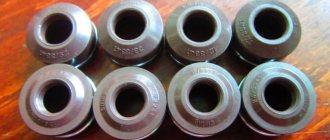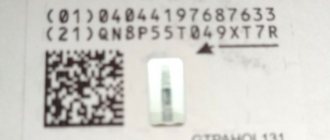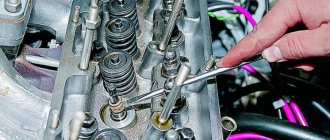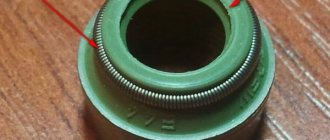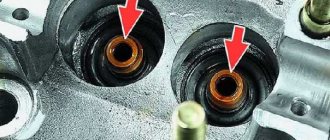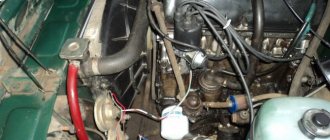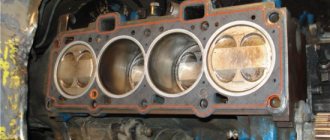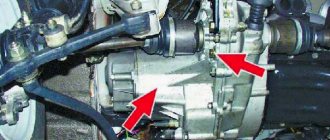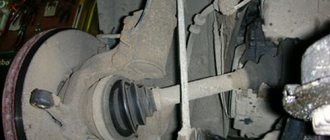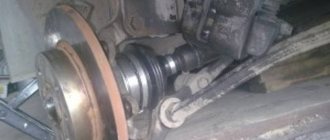According to many years of experience of various car enthusiasts, replacing the cylinder head of a VAZ 2109 is most often associated with problems arising with the gasket. But there may be others that can cause the engine to overheat or even seize.
Every driver can repair and modify the cylinder head on a VAZ 2109, but special tools and a little knowledge of the operating principle of this unit are required. Recently, tuning of this unit has become increasingly popular, due to which the power of the car increases. Carrying out tuning yourself is possible if you have experience in such work. Working with valves and actuators requires specialized knowledge and skills.
Symptoms of a problem
If the valves have not been adjusted properly, a characteristic clattering sound appears when the engine starts. This rather loud noise comes from under the block cover. You can hear it especially well when the speed increases.
If the valve clearance is significantly larger than specified, the loud clatter becomes more distinct, and noise appears even at low engine speeds.
Adjustment
To adjust the gap, you must use the appropriate shims. They are installed on top of the valve tappets.
If you choose the right shim using trial and error, you can return the clearance to optimal values, thereby restoring normal engine operation.
There are certain standards regarding clearance sizes depending on the valve.
Valve type
Normal clearance
Tolerance
Adjustment process
Adjusting the gaps yourself is not difficult. Just follow the instructions provided, as well as video tips and visual demonstrations of the process.
- Remove the unit cover and clean the surfaces with a clean rag. You need to remove traces of engine oil.
- Place a device for recessing the valve tappets on the cover fastener studs. This is the most common lever with a handle.
- Set the piston of the first cylinder to the TDC position - top dead center. To do this, remove the camshaft drive belt cover and rotate the crankshaft as it rotates. The marks on the camshaft drive gear and the rear gear cover must match. If you remove a couple of spark plugs, it will be easier to turn the crankshaft.
- After aligning the marks, the crankshaft rotates about another 50 degrees, no more. This will allow you to unscrew the camshaft cam from the valve lifters.
- Using a feeler gauge, check the condition of the gaps on valves 1-3 and 5. If the gap differs from the required one, return the required parameters by replacing the adjusting washers.
- To adjust the clearances, the pushrods are recessed a little so that you can release the shims. The pushers are recessed by pressing the lever. Do not let go and lock it in the desired position. Be sure to place the clamp so that it is between the edge of the pusher and the camshaft.
Fixing the pusher
- Pry the adjusting washer off the pusher by prying it with a flat-head screwdriver. On the back of the washers there is usually a mark with the size. If not, you will have to measure it manually. Write down somewhere how thick the washer you are using is, and using the dimensions as a guide, select a new washer.
- New shims must be installed with the numbers down. By recessing the device for compressing the valve pusher, the retainer can be removed.
- Check the gap. If necessary, perform the operation again, taking a washer larger or smaller than the previous one.
- Having completed the adjustment, the crankshaft rotates 360 degrees, which provides access to valves 4, 6, 7 and 8. They are adjusted in the same way.
Checking the quality of work
After completing the repair, it is necessary to check the operation of the engine. First, we install all the dismantled elements in place and screw in the spark plugs. After starting the engine, there should be no knocking of valves or other extraneous noise. We recommend carrying out checks for 15-20 minutes - this will ensure that the cylinders are operating normally even after heating.
It is not difficult to adjust the valves on the VAZ-2109 model yourself. You can do this work yourself, the main thing is to have a special kit and a couple of hours of free time. Using step-by-step instructions and an adjustment diagram, you will do the job efficiently and save on a trip to the car service center.
Problematic seals
In addition to adjusting the valves, it is extremely important to check the current condition of the seals.
Valve seals are designed to prevent excess engine oil from leaking through. In ideal operating condition, they seal tightly against the valve and allow only the amount of oil to flow through to provide effective lubrication.
Valve seals
They sometimes have to be changed, since the rubber used to make oil seals ages over time and loses its elasticity. As a result, the oil seal leaks more oil than required. Engine oil consumption increases, problems arise in the lubrication system and more.
Therefore, we offer you instructions on how to replace them.
- The work begins with the obligatory removal of the negative terminal from the battery.
- Disconnect the contacts from the ignition coil and move them aside. It is better not to unscrew the spark plugs, otherwise you risk providing the cylinders with an impressive amount of dirt during the repair process.
- Disconnect a pair of rubber tubes from the valve cover. Loosen the valve cover mounting screws and unscrew them. Subsequently, put all small parts, nuts, bolts in a separate jar so as not to lose anything.
- Remove the valve cover and a pair of gaskets. It is best to replace these gaskets immediately.
- In order not to remove the cylinder head side cover, which covers the camshaft chain and sprockets, you can move the sprockets into the cover as far as it will go and remove the shafts from them.
- Remove the spark plugs. First, insert the oil dipstick into the spark plug hole until the end touches the piston. After this, carefully rotate the pulley until the dipstick stops before lowering.
- Using a marker or paint, make marks on the sprockets and chain, fixing the required position of the teeth in the chain. This way, when reassembling, you will be able to correctly return the chain to the teeth on which it was located before dismantling.
- Unscrew the sprockets using an open-end or socket wrench. To prevent the cylinders from turning, secure the large pulley below the wheel with a key.
- Remove the shaft mounting yokes. The one next to the stars is removed first. Next, all the others are removed, adhering to the order of weakening. Place all the elements on a rag in the order in which you removed them. This way you won't get confused when reassembling.
Replacement procedure
- Remove the stars from their nests. The first one is easily removed in the area of the cylinder head side cover, if you remove the shaft position sensor first. It is held on by one bolt, so there should be no problems here.
- Having freed the shafts from the yokes, lift them a little using a flat-head screwdriver, and then remove them from the sprockets.
- After removing the shafts, remove the near sprocket and secure the chain with a slight tension.
- Next, the valve cups are dismantled. They are shiny, so it is difficult to confuse them. Although no cup holders are used, removing them can be a problem. They stick from the inside. Try using a powerful magnet.
- Remove the springs. To do this, you will need to loosen the valves on cylinders 1 and 4. This is due to the fact that on them the piston is at TDC. Secure the outer bracket with a bolt using a suitable hole in the block head. Using the second bracket, jerk the washer until it stops. The crackers should come free, after which you carefully remove them from their seats with a magnetized screwdriver.
- Remove the springs along with the washer. Place them on the table in the order in which you removed them. That's it, we finally got to our oil seals.
- Use pliers to remove the old seals. This can take quite a long time.
- Put on new oil seals, treating them with engine oil first.
- Press into place using a washer or tube of the required diameter.
- Put the springs back in place and dry them. Here you need to be as careful and attentive as possible. We recommend covering the engine with a rag. Having dried the valves of cylinders 1 and 4, move the pistons of cylinders 2 and 3 to TDC, then repeat the operation.
- Having dried the last valve, proceed to reassemble the unit. Here, strictly follow the reverse sequence.
Valve adjustment technique
After you have completed the preparatory work, you can begin to regulate.
If you have already done repair work on a car, then the adjustment procedure will not seem difficult to you. The adjustment must be carried out in the order of the cylinders. It should be remembered that valves 2, 3, 6, 7 are intake valves, and the remaining numbers are exhaust.
To make work easier, you can mark the camshaft pulley with special marks in a circle with a distance of 90 degrees. When the camshaft is rotated 90 degrees, the crankshaft will rotate 180 degrees.
Align the marks on the pulley and on the belt housing panel, then turn clockwise another 2 teeth. This scheme will allow you to move the cams.
Measure the gap using a feeler gauge. If it moves between the pushrods and cams with little effort, everything is correct.
In the event that the gaps do not coincide with the nominal ones, the following must be done:
- install a tool to adjust the gap on the bearing studs;
- turn the pusher so that the hole is facing you. Using the lever, move the pusher until it stops, and then lock it;
- remove the washer using tweezers, you will find a thickness mark on it.
To make it easier to select a new washer, you will need a special formula that can be used to calculate the thickness: H = A + (B – C).
Decryption table:
- thickness of the new washer – N;
- thickness of the old one – A;
- present gap – B;
- the required gap is C.
When you calculate the required thickness of the washer and install it, you need to measure the gap again. Repeat this step until you get the size you want. For the remaining cylinders, carry out adjustments in the same order.
Replacement of VAZ valves.
Good afternoon dear readers. Having searched the Internet for information on replacing valves, I found practically nothing concrete. Therefore, I will try to explain in detail the entire valve replacement process.
When the engine needs valve replacement. There are times when the timing belt breaks. Or the motor chain jumps (which I highlighted more than once). With such actions, on some engines the valves simply bend and their further operation is impossible. And they look something like this.
Next is wear on the valve stem. You need to measure the size with a micrometer. If the valve stem is smaller than 7.97 mm. This means it needs to be sent for repairs. How valves are repaired, we’ll talk about this a little below. And the last thing that can happen to the valve is a burnout or crack of the plate itself.
So, let's get down to business. First of all, we cannot do without a special tool with which we will remove the valves.
The replacement method is the same on classic VAZ models, on eights and the like.
Now we need to remove the camshaft from the head to gain access to the valves. I recommend that you read the article (Repair of G.B.Ts. VAZ), it contains a detailed and step-by-step explanation of how to do everything correctly, and you will also learn a lot of other useful information. After removing the camshaft, remove the pushers on the eights and the rocker on the classics.
We attach our device to the studs of the gas camshaft and, placing a small stand under the valve plate, remove the fastening crackers.
Be careful, the springs are very powerful and if the device comes off the plate, the springs will throw crackers, God only knows where, and then you will need to look for new crackers.
Once you have removed both crackers, remove the plate with the springs.
There are also thrust plates under the springs, which also need to be removed, but on classic models the plate can be removed immediately, and on models of the eighth generation and beyond only after removing the valve seal. To remove the oil seal, there is a special grip with which we remove it.
The removal process is as follows. Clamp the oil seal with a grip and press it a little. Pressing it, make as many turns to the right and left. At the moment of turning, pull the grip upward. You cannot bend the grip to the right and left with the clamp pressed, otherwise you can damage the seating collar of the oil seal on the guide sleeve.
Now all we have to do is pull out the old valves. If the valves are to be reused, they must be marked.
The marks are applied like this.
Marks are made at the end of the valve plate with a punch, the first cylinder has one mark for each valve, and so on. On the fourth cylinder the valves are not marked, because it’s already clear :).
Next, all we have to do is install new valves and put everything back together. How to properly replace valve seals, see the article on repairing the G.B.Ts. link at the top of the article. It is also worth checking the condition of the valve guides; if replacement is required, the article (Replacing VAZ valve guides) will help you with this. I also recommend that you read the article (Lapping in VAZ valves).
And finally, I almost forgot. Now let's talk about valve repair. Nowadays, I would say that finding high-quality valves is very difficult. I saw how a head, after repair, traveled ten thousand and became unusable to such an extent as if one and a half million kilometers had been driven on it. The wear and tear was simply stunning. Therefore, if anyone has the opportunity (fortunately, this is available nowadays), old valves can be chrome-plated and then ground to the desired size. Old valves are one hundred percent high quality, and it is not advisable to throw them away. I repeat, if you have the opportunity to go around the factories and ask the craftsmen if they can do such work, this will be the best option.
Which adjustment devices are best to choose?
Conventional tools are not suitable for precise and quick adjustments . Special devices are used with which you can fix the pusher and carry out other work. Today there are special adjustment kits on sale, their cost is low. Purchasing such a kit will be more profitable than trying to make devices from improvised means. Not everyone will be able to find suitable materials and make a dipstick or clamp correctly, and in case of poor-quality repairs, engine performance can become even worse.
Fines for crossing the stop line and speeding will no longer bother you!
Symptoms of a problem
If the valves have not been adjusted properly, a characteristic clattering sound appears when the engine starts. This rather loud noise comes from under the block cover. You can hear it especially well when the speed increases.
If the valve clearance is significantly larger than specified, the loud clatter becomes more distinct, and noise appears even at low engine speeds.
Adjustment
To adjust the gap, you must use the appropriate shims. They are installed on top of the valve tappets.
If you choose the right shim using trial and error, you can return the clearance to optimal values, thereby restoring normal engine operation.
There are certain standards regarding clearance sizes depending on the valve.
Valve type
Normal clearance
Tolerance
Adjustment process
Adjusting the gaps yourself is not difficult. Just follow the instructions provided, as well as video tips and visual demonstrations of the process.
- Remove the unit cover and clean the surfaces with a clean rag. You need to remove traces of engine oil.
- Place a device for recessing the valve tappets on the cover fastener studs. This is the most common lever with a handle.
- Set the piston of the first cylinder to the TDC position - top dead center. To do this, remove the camshaft drive belt cover and rotate the crankshaft as it rotates. The marks on the camshaft drive gear and the rear gear cover must match. If you remove a couple of spark plugs, it will be easier to turn the crankshaft.
- After aligning the marks, the crankshaft rotates about another 50 degrees, no more. This will allow you to unscrew the camshaft cam from the valve lifters.
- Using a feeler gauge, check the condition of the gaps on valves 1-3 and 5. If the gap differs from the required one, return the required parameters by replacing the adjusting washers.
- To adjust the clearances, the pushrods are recessed a little so that you can release the shims. The pushers are recessed by pressing the lever. Do not let go and lock it in the desired position. Be sure to place the clamp so that it is between the edge of the pusher and the camshaft.
Preparatory work
From the adjustment tool you will need:
- set of wrenches;
- special device for adjustment;
- measuring probe;
- several adjusting washers;
- screwdriver;
- tweezers;
- valve cover gaskets.
Before starting the repair, set the car to the handbrake and engage any gear. One of the front wheels must be suspended so that the crankshaft can turn easily.
The procedure is as follows:
- Raise the hood.
- Disconnect all pipes from the cover.
- Remove the windshield wiper housing.
- We unscrew the spark plugs.
- Remove the front timing belt cover.
Tip: To monitor the current position of the piston, you need to use the viewing window.
Problematic seals
In addition to adjusting the valves, it is extremely important to check the current condition of the seals.
Valve seals are designed to prevent excess engine oil from leaking through. In ideal operating condition, they seal tightly against the valve and allow only the amount of oil to flow through to provide effective lubrication.
Valve seals
They sometimes have to be changed, since the rubber used to make oil seals ages over time and loses its elasticity. As a result, the oil seal leaks more oil than required. Engine oil consumption increases, problems arise in the lubrication system and more.
Therefore, we offer you instructions on how to replace them.
- The work begins with the obligatory removal of the negative terminal from the battery.
- Disconnect the contacts from the ignition coil and move them aside. It is better not to unscrew the spark plugs, otherwise you risk providing the cylinders with an impressive amount of dirt during the repair process.
- Disconnect a pair of rubber tubes from the valve cover. Loosen the valve cover mounting screws and unscrew them. Subsequently, put all small parts, nuts, bolts in a separate jar so as not to lose anything.
- Remove the valve cover and a pair of gaskets. It is best to replace these gaskets immediately.
- In order not to remove the cylinder head side cover, which covers the camshaft chain and sprockets, you can move the sprockets into the cover as far as it will go and remove the shafts from them.
- Remove the spark plugs. First, insert the oil dipstick into the spark plug hole until the end touches the piston. After this, carefully rotate the pulley until the dipstick stops before lowering.
- Using a marker or paint, make marks on the sprockets and chain, fixing the required position of the teeth in the chain. This way, when reassembling, you will be able to correctly return the chain to the teeth on which it was located before dismantling.
- Unscrew the sprockets using an open-end or socket wrench. To prevent the cylinders from turning, secure the large pulley below the wheel with a key.
- Remove the shaft mounting yokes. The one next to the stars is removed first. Next, all the others are removed, adhering to the order of weakening. Place all the elements on a rag in the order in which you removed them. This way you won't get confused when reassembling.
Replacement procedure
- Remove the stars from their nests. The first one is easily removed in the area of the cylinder head side cover, if you remove the shaft position sensor first. It is held on by one bolt, so there should be no problems here.
- Having freed the shafts from the yokes, lift them a little using a flat-head screwdriver, and then remove them from the sprockets.
- After removing the shafts, remove the near sprocket and secure the chain with a slight tension.
- Next, the valve cups are dismantled. They are shiny, so it is difficult to confuse them. Although no cup holders are used, removing them can be a problem. They stick from the inside. Try using a powerful magnet.
- Remove the springs. To do this, you will need to loosen the valves on cylinders 1 and 4. This is due to the fact that on them the piston is at TDC. Secure the outer bracket with a bolt using a suitable hole in the block head. Using the second bracket, jerk the washer until it stops. The crackers should come free, after which you carefully remove them from their seats with a magnetized screwdriver.
- Remove the springs along with the washer. Place them on the table in the order in which you removed them. That's it, we finally got to our oil seals.
- Use pliers to remove the old seals. This can take quite a long time.
- Put on new oil seals, treating them with engine oil first.
- Press into place using a washer or tube of the required diameter.
- Put the springs back in place and dry them. Here you need to be as careful and attentive as possible. We recommend covering the engine with a rag. Having dried the valves of cylinders 1 and 4, move the pistons of cylinders 2 and 3 to TDC, then repeat the operation.
- Having dried the last valve, proceed to reassemble the unit. Here, strictly follow the reverse sequence.
Reassembly often causes problems for those who do not take into account useful tips during disassembly of the unit - marking, arranging dismantled parts in sequence, storing fasteners in separate containers, etc.
Adjusting the valves and changing the seals on them is not the easiest task, but it can be done with your own hands. Be patient and follow the instructions.
Symptoms of a burnt valve
The main sign of a burnt-out valve is a distinct tripping of the engine in all operating modes. Power also drops noticeably and fuel consumption increases. Signs of failure are similar to other engine problems, and it is easy to confuse it with the following problems:
- Wear of piston rings and loss of compression in the cylinders.
- Breakage of high-voltage wires and spark plugs.
- Failure of injectors and malfunctions of the power system.
To accurately diagnose the malfunction, exclude all of the above options in the following order:
1. Checking the serviceability of the spark plugs is carried out with the engine running at idle speed by sequentially disconnecting the cap of each spark plug. When removing, carefully monitor the engine reaction and stability of its operation. If the engine starts to run worse, it means the valves in the cylinder are intact. If the nature of the operation has hardly changed, then most likely the problem cylinder has been detected.
We recommend: How to quickly and easily replace a generator bearing on a VAZ 2110?
2. On the faulty cylinder, replace the spark plug with a known working one, check the high-voltage wire and ignition coil. After starting the engine, it becomes clear whether there was a breakdown in the ignition system, or whether further diagnostics are required.
3. If, when replacing faulty parts of the ignition system, the engine continues to stall, the cause of the breakdown may be a burnt-out valve or a malfunction in the piston group in the form of sticking or wear of the rings. Both failures lead to low compression in the problem cylinder, but by measuring it it will not be possible to determine which of the two failures occurred. To do this, perform the following additional diagnostics:
- After measuring the compression, pour a few ml of engine oil into the problem cylinder through the spark plug hole and take another measurement. If the compression has increased, then the problem is with the rings, if not, then the valve has burned out;
- The spark plug on the problem cylinder is inspected. If the valve is burnt out, it will be completely dry and without any oil deposits. If the failure is related to the piston group, then the spark plug will be covered with oil, and when the engine is running, bluish smoke can be observed from the removed breather.
Step-by-step steps for replacing valve stem seals on a VAZ 2109
Replacing valve stem seals (valve seals) for VAZ 2108–2109 vehicles is carried out in the same way. The need for such an operation arises due to natural wear and tear or poor quality of parts. Valve seals are exposed to aggressive environments and varied temperature conditions. If necessary, not just one individual cap is replaced, but the entire group.
Why are thermal gaps needed?
The term thermal clearance adjustment is usually used among car enthusiasts, but it would be more correct to call this process this way: adjusting the thermal clearances between the camshaft cam and the valve stem. But usually such a slightly abstruse name is used in technical literature, and in colloquial speech the wording is valve adjustment.
There is a thermal gap between the camshaft cam and the valve stem, which is measured at the manufacturer.
The thermal gap on a VAZ 2109 car is measured using a special probe on a cold engine, that is, with a temperature of up to +20 ⁰C between the camshaft cam and the pusher adjusting washer.
If some metallic knocking occurs, the valves need to be adjusted.
Do not immediately contact a car service center, as you can carry out this fairly simple procedure yourself. This way you can save about a thousand rubles. Believe me, this procedure is not so complicated that you need to pay that kind of money for it, because for this you will only need to purchase a special set of tools.
Valve adjustment process
Adjusting valves VAZ 2109
On VAZ 2109 cars, the thermal gap is adjusted using specially adapted washers. adjustment of thermal clearances on a VAZ 2109 car is carried out with the engine idling.
So, the algorithm for adjusting the valves on a VAZ 2109 car:
- Remove the cylinder block cover. To perform this step, dismantle the air filter, disconnect the pipe attached to the valve cover, but before that, first loosen its clamp. After this, disconnect the throttle valve control mechanism from the valve cover and carefully remove the cylinder block cover;
- Unscrew the spark plugs;
- Remove the front plastic cover protecting the gas distribution system;
- Rotate the car engine crankshaft clockwise until the mark on the timing system pulley aligns with the mark on the rear cover. The crankshaft can only be turned using a wrench using the bolts securing the generator pulley. If you accidentally missed the mark, turn the car engine a few more revolutions;
- After the marks have come together, rotate the crankshaft a few more teeth of the gas distribution system;
- Measure the thermal clearance of the exhaust valve of the first cylinder and the intake valve of the third cylinder. For exhaust valves, according to the standard, it is approximately 0.2 millimeters, and for exhaust valves, 0.4 millimeters;
- If the thermal clearances do not match the standard, then you need to lower the cylinder piston to the lowest position and, using a special device, remove the installed washers;
- We measure the size of the required washer; to do this, subtract the value of the recommended gap from the size of the thermal gap, and then add the thickness of the washers used to the resulting value;
- Measure the thermal clearance value for each valve in turn, with each crankshaft turn half a turn;
- Install washers of suitable thickness and repeat the measurements again.
We recommend: How to install bi-xenon H4 with your own hands: diagrams and connection sequence
Functional purpose, causes and signs of wear
Oil seals are an important part that ensures productive engine operation. Valve seals serve to lubricate the gas distribution mechanism. They prevent oil from leaking and entering the combustion chamber. The caps remove oil from the moving valve.
Valve seals separate two working areas of the engine: the cylinder head and the combustion chamber. The upper part of the cap is constantly in the area of intense movement of lubricant of the VAZ 2109 engine. The lower part is in contact with the combustible fuel mixture and gas waste. Therefore, the caps are subject to intense loads.
The rubber elements of the seals lose their elasticity and delaminate. As a result, oil flows through the valve into the combustion chamber and onto the spark plugs. The wear of oil seals accelerates when they are made of low-quality materials.
It is impossible to visually verify the working condition of the VAZ 2109 oil seals. These parts are hidden and are not easy to get to. Indirect signs indicate that there are problems with the seals:
- excess oil consumption; thick bluish-blue smoke from the exhaust pipe; oily coating on candles.
Signs you need to adjust your valves
Valve Adjustment Chart
The specificity of VAZ 2109 cars in comparison with the “classic” family is that their engines tend to reduce clearances. The insidiousness of this problem is that it may not appear audibly. On the “seven”, the roar of the valve hitting the cam will quickly tell you that it’s time for the car to be adjusted.
The main signs of large gaps are uneven engine operation (cold or hot, sometimes constantly), “sneezing”, detonation, unpleasant smell under the hood, low compression. These signs often indicate an incorrect carburetor or ignition setting. When setting them up doesn’t help, an inexperienced owner of a “Nine” can attribute the symptoms to unfortunate carburetor makers or the Russian auto industry, although the problem is under the hood.
If you do not adjust the valves on the VAZ 2109, engine repair cannot be avoided. Moreover, in advanced cases, literally everything can be replaced, from rings and seals to the camshaft.
How to make a replacement
Replacing oil seals in a VAZ 2109 engine is a relatively labor-intensive procedure that requires special skills and certain tools. It is advisable to carry it out in a garage or workshop. Allow enough time for work so as not to rush. Replacing oil seals in a VAZ 2109 engine requires care, precision, and attentiveness.
Prepare everything you need
Successful replacement of valve stem seals can be done with your own hands. But this will require more than just a simple set of keys. You will have to take care of preparing special devices. Before starting work, you must equip:
- tin (or soft metal) rod with a diameter of no more than 8 mm;
- desiccant;
- tweezers;
- hammer;
- set of keys, socket heads;
- pliers;
- collet (puller) for removing oil seals;
- flat screwdrivers;
- press-fit frame.
Step by Step Actions
You can change the valve seals by removing the cylinder head (cylinder head). Some experts claim that this is the only and most reliable way. However, in practice, most car enthusiasts ignore this belief and change oil seals without dismantling the cylinder head.
First, preparatory work is carried out:
- disconnect the negative terminal;
- remove the gear from the camshaft by carefully pulling out the key;
- by unscrewing the bolts located around the perimeter, dismantle the cylinder head cover (front);
- remove the back part of the cover (ignition distributor plug);
- remove the camshaft with oil seal.
- turn the crankshaft so that the piston under the cap being replaced reaches top dead center; having unscrewed the spark plug, insert a tin rod into the hole to prevent the valve from falling out;
- using a desiccant, the springs are removed from the valve;
- remove the crackers using tweezers;
- take out the upper spring plate, inner and outer valve springs;
- put the collet on the cap, dismantling it; craftsmen carry out this operation with pliers or screwdrivers;
- before installing a new cap, remove the spring from it;
- the prepared cap is dipped in engine oil and inserted into the mandrel;
- carefully press the cap until it rests on the bottom plate;
- return the spring from the cap to its place;
- the remaining valve seals are changed in the same way;
- replacement ends with the assembly of components and parts in the reverse order of removal;
- the rod is removed from the spark plug hole;
- after installing the crackers, substituting a metal rod, hit the valve ends with a hammer - the crackers are seated in place;
- when installing the camshaft, monitor the direction of the cams of the 1st cylinder - they should “look” in the direction opposite to the valve tappets;
- When reinstalling, all rubbing parts are lubricated with engine oil.
For better clarity, you can watch a video showing the replacement of valve seals in a VAZ engine. The demo video will present all the steps, after going through which you can change these important details yourself.
Process
At the beginning of any repair operation, you need to put the car in “handbrake” and leave the gear engaged. In addition, when adjusting, you need to lift the front wheel and leave it hanging, this is necessary to turn the crankshaft.
Then you should do the following:
- Open the hood lid.
- Disconnect the pipes.
- Remove the wiper housing.
- Unscrew all spark plugs.
- Remove the cover that covers the timing belt.
A special window helps you see in what position the piston is located.
After preparation, you can begin the main procedure. Adjustment for all models of domestic manufacturers is carried out in an almost identical manner. If a car enthusiast has already carried out similar operations on other models, then it will not be difficult for him to understand the “nine”. It is necessary to set the gaps in the order of operation of the cylinders. If you count from the camshaft belt, then the exhaust valves are 1, 4, 5 and 8. During the repair, a special table will be useful.
When do you need to change seals?
The fact that they have fallen into disrepair is evidenced by:
- high oil consumption, with no signs of leakage;
- increased fuel consumption;
- traces of grease on the spark plug contacts.
Moreover, the last point is the most reliable evidence of oil seal failure for the simple reason that there is simply nowhere else for the oil to appear.
Regardless of whether you have an injector or a carburetor in your car, the seals are changed in the same way. The only thing that owners of the latter should know is that before starting work you will need to first dismantle:
- gasoline pump;
- Air filter;
- generator drive housing;
- distributor.
How to know when it's time to change
It's simple: if thick bluish smoke comes out of the car's exhaust pipe, then it's time to change the caps . As a rule, this smoke appears only when the engine starts and when it stops. But if the caps are very worn, thick smoke constantly comes out of the chimney.
However, smoke is not the only sign that the caps need to be urgently replaced. Sometimes smoke is practically not visible, but oil consumption in the car increases several times, while no external oil leaks (through various oil seals and gaskets) are observed. All this also suggests that it’s time to change the caps.
Mechanical fuel pump repair
The functionality of a mechanical fuel pump can be restored by replacing its faulty elements. You can buy them at any automobile store. But it is better to buy not individual spare parts, but a repair kit. It includes all the elements that can fail:
- intake and exhaust valves;
- diaphragms with spacers, “plates”, rod;
- pusher;
- thermal spacer;
- gaskets
Replacing valves
To replace the pump valves you will need a slotted impact driver and a small hammer. The valves are held in their seats by punching at three points. These areas must be carefully knocked off with a screwdriver. After this, the valves can be removed. Having installed the new parts, we secure them with cores. To do this, place the tip of the screwdriver on the edge of the housing along the circumference of the socket and strike it lightly with a hammer. We fix each valve in three places.
How to change apertures
To replace the diaphragms, you need to unscrew the nut by 10 in the upper part of the rod. Next, we remove the damaged elements, and in their place we install parts from the repair kit.
The kit includes three diaphragms: two working and one safety. The latter serves to prevent unauthorized fuel from entering the carburetor if the first two are damaged. It is installed at the very bottom of the rod immediately after the lower “plate”. We place spacers on top of it on the rod: first a small one, then a large one. We place the working membranes and the upper “plate” on them. We secure the resulting structure with a nut.
The mechanical fuel pump has 3 diaphragms
Replacing the pusher, thermal spacer and gaskets
The thermal spacer does not need to be replaced unless it is damaged. Inspect its mating surfaces, especially the outer one, to which the lower part of the pump housing is attached. It should be perfectly smooth. Otherwise, oil leakage may occur at the junction of parts during engine operation.
Replacing the pusher is carried out by removing the old one and installing a new rod in its place. There is no difference in which end where it will be installed.
Now about the gaskets. There are only three of them in the repair kit, and they have different thicknesses:
The first is intended for installation between the thermal spacer and the auxiliary drive housing, and the gaskets “B” and “C” are used to adjust the protrusion of the pusher above its mating surface.
The adjustment is made as follows:
- We install the thermal spacer with the first gasket and a new rod into the auxiliary drive housing.
Installation of gaskets and thermal spacer
The thinnest gasket is installed between the spacer and the accessory drive housing
The pusher should protrude 0.8–1.3 mm above the mating plane of the spacer
After the adjustment is completed, the fuel pump is installed in place and secured with nuts.
Execution technology
The work is complex, but if you have the necessary skills, it can be done in a garage.
There are several ways to remove the saddle. A quick, but not very correct method is to weld the valve onto the seat and then knock it out. The valve is ground to the size of the seat, inserted into it and scalded. Until the metal had time to cool. The saddle must be knocked out with a hammer. The entire structure should come out without any problems. But remember that welding heats up the metal, which can cause deformation of the head. By knocking it out, you can damage the seat under the saddle, which will entail additional work on processing the cylinder head. It is best to use a lathe. This way you can grind the saddle to such a size that it becomes like foil and can be easily taken out. If you don’t have a machine, you can use a drill and a cutter attachment. Stitching is carried out on one side until the tension weakens. The saddle can now be reached by hand.
The ideal option for installing a new seat is nitrogen, in which the seats should be pre-cooled. The fact is that their dimensions are slightly larger than the holes, and due to cooling the outer diameter decreases. Naturally, nitrogen in the garage is very rare. Then remember the properties of metal to expand and contract. The saddle is simply placed in the freezer for a couple of hours, and the hole is heated with a burner.
This is interesting: Renault Logan - replacing lamps in a headlight with your own hands
If during installation it will be necessary to apply force, it is recommended to take a block suitable for the diameter of the seat and use it to press it.
Removing the seat
First, let's look at what not to do, although some automotive garage gurus recommend doing just that.
-valve welding + knocking out
First, the old unnecessary valve is adjusted to the dimensions of the seat, inserted onto the seat and the valve is welded to the seat. While it is still warm, knock out the valve and it comes out along with the seat. Due to the different expansion of metals - steel and aluminum - the tension decreases; when it cools down, it will not be so easy to come out.
Why shouldn't you do this? During welding, the entire head heats up and it will certainly move, it will become crooked and in addition to this, hidden cracks will open where there were internal stresses in the metal (and they exist in any case). Then you will wonder why my head suddenly turned out to be pierced.
The best way is to bore the valve seat on a machine until it becomes the size of foil and jumps out of the seat hole. But... this cannot be implemented in a garage due to the high cost of the equipment, and not every village will have such a machine. Therefore, let’s consider another method, easy and safe, and can be implemented in any garage.
Choosing garage technicians: a simple and safe way
Using a milling cutter, grind the saddle all the way through one edge. The seat will weaken, lose tension and jump out of the seating hole on its own, without even having to sharpen it through, reaching the seating plane, when a little less than 0.5 mm of tension remains, the tension is no longer enough to hold on. By opening the ring, the saddle will no longer be able to resist.
A drill cutter is sold in any hardware store and costs no more than a drill, which is why this method is so affordable.
Now that the saddle is out, we need to think about what we are going to put in there.
Stuffing the valve seals
But first you need to remove the old valve seals, on Zhiguli they must be removed carefully and in no case should you try to knock them off with a blow, the place where the seal is packed will break off, take pliers, hold the valve seal with them and try to turn it if it doesn’t work right away, grab it and try to turn it again, then grab it with the pliers and the valve seal will loosen and rotate and come out. Also remove the valve seals from the UAZ and GAZ.
And now we will fill the valve seals on the Zhiguli, insert the valve and put the valve seal on it up to the guide sleeve, take a tube with an internal diameter of 13 mm and carefully, with a light hammer, tap the valve seal with light blows, just do not overdo it, otherwise you will break the seal. If there is no such tube, you can flatten the larger tube a little to size, and saw the smaller one a little lengthwise and spread it to size. You can also first remove the spring from the valve seal so as not to accidentally damage it and then put it on the seal.
On UAZ and Gas, fill it in the same way as on Zhiguli, but the tube should have an internal diameter of 16mm.
Dry the valve
It was easy to remove the valve, but drying the valve without a valve remover is not very easy, but you can, put a piece of iron under the valve so that it rests on it, put on the springs, place a plate of springs on the springs and put crackers in it, take a 19 or 22 open-end wrench and firmly press on the springs and let your friend insert the crackers, this is all checked, I inserted the crackers into the valves like this several times.
Grinding the valve to the head
If the valve is burnt out, then the valve seat is also burnt out; usually mechanics first level the seat with a special cutter, which you don’t have; no, we can do without it (the engine has been tested and runs no worse). I’m amazed at how some motorists grind valves by hand (I’d go crazy) let an electric drill do the work for us (if you have a left-right reverse drill, it’s even better, but if not, this one will do). Spread the edge of the valve with rubbing powder, insert the valve into the head and clamp the end of the valve into the drill chuck, but not deeply, but to a depth of about 15 mm, the main thing is not to scratch the place where the valve comes into contact with the oil seal. Pull the valve up with a drill and turn it on, let the valve grind, make such movements up a little down and up again (I think you understand) if the drill is in reverse, switch the rotation. On a nine or eight, it is difficult to reach the valve with a drill; you need a very small chuck, but you can do this by taking a strong piece of reinforced rubber hose that fits very tightly onto the valve, take an 8mm pin and pull this piece of hose onto it as tightly as possible, clamp the pin into the drill and the other end hose onto the valve and also begin to grind the valve onto the head seat.
This is interesting: Starter for VAZ: where is it located, how to remove, replacement instructions for a Niva car
